Class 7 | Science | Chapter 13 |
Motion and Time | NCERT Solutions
Question 1. Classify the following as motion along a straight line, circular or oscillatory motion:
(i) Motion of your hands while running.
(ii) Motion of a horse pulling a cart on a straight road.
(iii) Motion of a child in a merry-go-round.
(iv) Motion of a child on a see-saw.
(v) Motion of the hammer of an electric bell.
(vi) Motion of a train on a straight bridge.
Answer 1
(i) Motion of your hands while running- Oscillatory motion
(ii) Motion of a horse pulling a cart on a straight road- Straight line motion
(iii) Motion of a child in a merry-go-round-circular motion
(iv) Motion of a child on a see-saw- Oscillatory motion
(v) Motion of the hammer of an electric bell- Oscillatory motion
(vi) Motion of a train on a straight bridge-Straight line motion
Question 2. Which of the following are not correct?
(i) The basic unit of time is second.
(ii) Every object moves with a constant speed.
(iii) Distances between two cities are measured in kilometres.
(iv) The time period of a given pendulum is constant.
(v) The speed of a train is expressed in m/h.
Answer 2
(i) The basic unit of time is second-Correct
(ii) Every object moves with a constant speed- Not correct
(iii) Distances between two cities are measured in kilometres- Correct
(iv) The time period of a given pendulum is constant- Not correct
(v) The speed of a train is expressed in m/h- Not correct
Question 3. A simple pendulum takes 32 s to complete 20 oscillations. What is the time period of the pendulum?
Answer 3 The time period to complete one oscillation is known as time period of the pendulum.
Time period= Total time taken / Number of oscillations
Time period= 32 / 20 = 1.6 sec
Question 4. The distance between two stations is 240 km. A train takes 4 hours to cover this distance. Calculate the speed of the train.
Answer 4 Speed= Distance travelled / Time taken
Speed= 240/4 = 60 Km/hr
Question 5. The odometer of a car reads 57321.0 km when the clock shows the time 08:30 AM. What is the distance moved by the car, if at 08:50 AM, the odometer reading has changed to 57336.0 km? Calculate the speed of the car in km/min during this time. Express the speed in km/h also.
Answer 5 Distance covered by car = 57336 – 57321 = 15 km
Time taken between 08:30 AM to 08:50 AM = 20 minutes= 20/60 = 1/3 hrs
Speed= Distance travelled / Time taken
Speed= 15 Km/ (1/3) hr = 45 Km/hr
Question 6. Salma takes 15 minutes from her house to reach her school on a bicycle. If the bicycle has a speed of 2 m/s, calculate the distance between her house and the school.
Answer 6 Speed= 2 m/s
Time taken= 15 min= 15 × 60 = 900 sec
Distance= speed × time= 2 × 900 = 1800 m = 1.8 Km
Question 7. Show the shape of the distance-time graph for the motion in the following cases:
(i) A car moving with a constant speed.
(ii) A car parked on a side road.
Answer 7 (i) A car moving with a constant speed.
(ii) A car parked on a side road.
Question 8. Which of the following relations is correct?
Answer 8
Question 9. The basic unit of speed is:
(i) km/min (ii) m/min
(iii) km/h (iv) m/s
Answer 9 (iv) m/s
Question 10. A car moves with a speed of 40 km/h for 15 minutes and then with a speed of 60 km/h for the next 15 minutes. The total distance covered by
the car is:
(i) 100 km (ii) 25 km
(iii) 15 km (iv) 10 km
Answer 10 (ii) 25 km
Case 1
speed = 40 Km/h
Time= 15 min= 15/60 hr
Distance= Speed × Time = 40 × (15/60)
Distance= 10 Km
Case 2
speed = 60 Km/h
Time= 15 min= 15/60 hr
Distance= Speed × Time = 60 × (15/60)
Distance= 15 Km
Total distance= 10 + 15 = 25 Km
Question 11. Suppose the two photographs, shown in Fig. 13.1 and Fig. 13.2, had been taken at an interval of 10 seconds. If a distance of 100 metres is shown by 1 cm in these photographs, calculate the speed of the fastest car.
Answer 11 From the figures we conclude that distance covered by blue car is 2 cm.
The distance covered = 2 × 100 =200 m
Time taken= 10 seconds
Speed = Distance/ Time
Speed= 200/ 10 = 20 m/s
Question 12. Fig. 13.15 shows the distance-time graph for the motion of two vehicles A and B. Which one of them is moving faster?
Fig. 13.15 Distance-time graph for the motion of two cars
Answer 12 Vehicle A is travelling longer distance in lesser time as compared to vehicle B.So, vehicle A is moving faster.
Question 13. Which of the following distance-time graphs shows a truck moving with
speed which is not constant?
Answer 13 (iii) Graph is not a straight line , so it shows a truck moving with speed which is not constant.
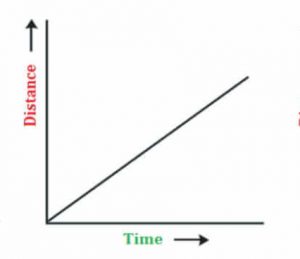
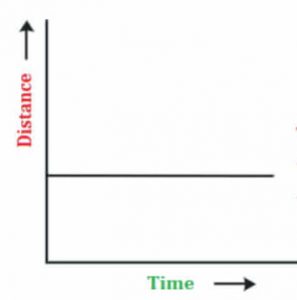


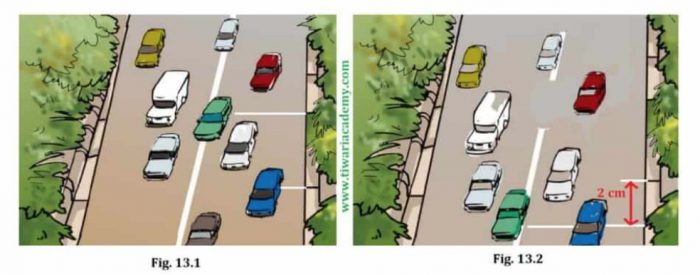
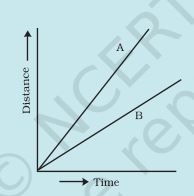
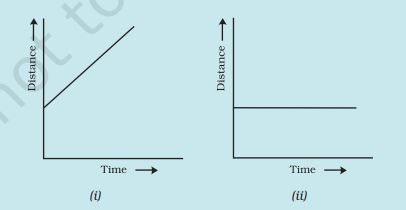
Leave a Reply